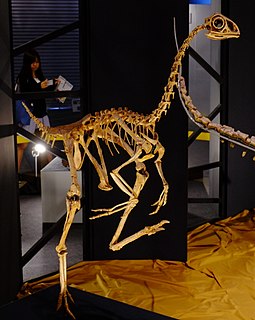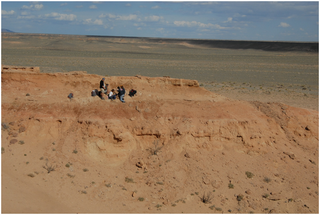
Tarbosaurus is a genus of tyrannosaurid dinosaur that flourished in Asia about 70 million years ago, at the end of the Late Cretaceous Period, considered to contain a single known species, Tarbosaurus bataar. Fossils have been recovered in Mongolia, with more fragmentary remains found further afield in parts of China.

Khaan was an oviraptorid dinosaur that was found in the Djadochta Formation of Mongolia and lived in the Late Cretaceous Period (Campanian), 75-71 million years ago.

Avimimus, meaning "bird mimic", is a genus of oviraptorosaurian theropod dinosaur, named for its bird-like characteristics, that lived in the late Cretaceous in what is now Mongolia, around 85 to 70 million years ago.

Saurornithoides is a genus of troodontid maniraptoran dinosaur, which lived during the Late Cretaceous period. These creatures were predators, which could run fast on their hind legs and had excellent sight and hearing. The name is derived from the Greek stems saur~ (lizard), ornith~ (bird) and eides (form), referring to its bird-like skull.

Saurolophus is a genus of large hadrosaurid dinosaur from the Late Cretaceous period of Asia and North America, that lived in what is now the Horseshoe Canyon and Nemegt formations about 70 million to 68 million years ago. It is one of the few genera of dinosaurs known from multiple continents. The type species, S. osborni, was described by Barnum Brown in 1912 from Canadian fossils. A second valid species, S. angustirostris, is represented by numerous specimens from Mongolia, and was described by Anatoly Konstantinovich Rozhdestvensky.

Byronosaurus is a genus of troodontid dinosaur from the Late Cretaceous Period of Mongolia.

Changchunsaurus is an extinct genus of small herbivorous parksosaurid dinosaur from Early Cretaceous deposits of Gongzhuling, Jilin, China. It is the first named dinosaur genus from Jilin.

The Nemegt Formation is a geological formation in the Gobi Desert of Mongolia, dating to the Late Cretaceous. The formation consists of river channel sediments and contains fossils of fish, turtles, crocodilians, and a diverse fauna of dinosaurs, including birds.

The Djadochta Formation is a geological formation situated in central Asia, dating from the Late Cretaceous Period. Laid down in the early Campanian, possibly starting in the latest Santonian, it is dated somewhat uncertainly at about 75-71 mya. The type locality are the famous "Flaming Cliffs", locally known as Bayanzag or Ulaan-Ereg.
The Bayan Mandahu Formation is a geological unit of "redbeds" located near the village of Bayan Mandahu in Inner Mongolia, China Asia and dates from the late Cretaceous Period. Laid down in the Campanian, it is dated somewhat uncertainly to between 75-71 mya.
Aiolosaurus is an extinct genus of monitor lizard from the Late Cretaceous of Mongolia. The type and only species, Aiolosaurus oriens, was named in 2000 from Ukhaa Tolgod, a rich fossil site in the Campanian-age Djadochta Formation.
Afairiguana avius is an extinct iguanid lizard known from a nearly complete and articulated skeleton discovered in rocks of the Early Eocene-aged Green River Formation of Wyoming, United States. As of the initial description, the skeleton represents the oldest complete iguanian from the Western Hemisphere, and is the oldest representative of the extant iguanid family of anoles, Polychrotidae.
Priscagamidae is an extinct family of iguanian lizards known from the Late Cretaceous of Mongolia and China and the Eocene of India, spanning a range from 75 to 54 million years ago. It includes the genera Heterodontagama, Mimeosaurus, Phrynosomimus, Priscagama, and possibly Pleurodontagama. The first fossils of priscagamids were found in the Djadochta and Khermeen Tsav formations of Mongolia. More recently they have been found in the Cambay Formation in India, leading to the naming of Heterodontagama in 2013. Priscagamidae was originally described as a subfamily of Agamidae called Priscagaminae in 1984, but it was reclassified as a distinct family in 1989. Most phylogenetic analyses still find a close relationship between Priscagamidae and Agamidae, although a 2015 study found it to be basal to all other iguanian clades, warranting its removal from Iguania and placement in a larger clade called Iguanomorpha.
Saichangurvel is an extinct genus of iguanian lizards from the Late Cretaceous of Mongolia. It is a member of a clade called Gobiguania, an exclusively Late Cretaceous group of iguanian lizards that was likely endemic to the Gobi Desert. The type species, Saichangurvel davidsoni, was named by paleontologists Jack Conrad and Mark Norell of the American Museum of Natural History in 2007. It is known from a single nearly complete and fully articulated skeleton called IGM 3/858, which was found eroding from a block of sandstone during a thunderstorm at a fossil locality called Ukhaa Tolgod. IGM 3/858 comes from the Djadochta Formation, which is between 75 and 71 million years in age. Just as it is today, the Gobi was a desert during the Cretaceous. IGM 3/858 may have died in a collapsing sand dune, the rapid burial preserving its skeleton in pristine condition.
Priscagama is an extinct genus of iguanian lizard from the Late Cretaceous of Mongolia and China. It belongs to an extinct family of iguanians called Priscagamidae. Several incomplete skulls have been found in the Barun Goyot and Djadochta formations, and were originally referred to the genus Mimeosaurus; the type species Priscagama gobiensis was named in 1984 when it was recognized that these skulls belonged to a distinct species. Priscagama differs from most other priscagamids in having a more elongate, lightly-built skull. It is very similar in appearance to another priscagamid called Pleurodontagama, as the two can only be distinguished by the shape of their teeth.
Phrynosomimus is an extinct genus of iguanian lizard from the Late Cretaceous of Mongolia belonging to the extinct family Priscagamidae. The type species Phrynosomimus asper was named in 1996. Fossils have been found in the Barun Goyot and Djadochta formations and include several complete skulls. Phrynosomimus has a short, triangular skull with bony spikes projecting from the back, stemming from the squamosal and parietal bones. These spikes give it a similar appearance to the modern horned lizard Phrynosoma and inspire its name, which means "Phrynosoma mimic". Like other priscagamids it has an acrodont dentition, meaning that its teeth grow from the margins of the jaws rather than their inner surfaces, as is the case for the pleurodont dentitions of most lizards.
Anchaurosaurus is an extinct genus of iguanian lizard from the Late Cretaceous of Inner Mongolia, China. It belongs to an extinct clade of iguanians called Gobiguania that was endemic to the Gobi Desert during the Late Cretaceous. The type species, Anchaurosaurus gilmorei, was named in 1995 on the basis of a well-preserved skull and incomplete skeleton from the Djadochta Formation. Compared to other iguanians, Anchaurosaurus has a relatively elongated skull, large eye sockets, and higher tooth crowns. Phylogenetic analysis indicates that among gobiguanians, Anchaurosaurus is most closely related to Zapsosaurus from Mongolia. Below is a cladogram from Daza et al. (2012) showing the phylogenetic relationships of Anchaurosaurus:
Magnuviator is a genus of extinct iguanomorph lizard from the Late Cretaceous of Montana, US. It contains one species, M. ovimonsensis, described in 2017 by DeMar et al. from two specimens that were discovered in the Egg Mountain nesting site. Magnuviator is closest related to the Asian Saichangurvel and Temujinia, which form the group Temujiniidae. Unlike other members of the Iguanomorpha, however, Magnuviator bears a distinct articulating notch on its tibia for the ankle bones, which has traditionally been considered a characteristic of non-iguanomorph lizards. The morphology of its teeth suggests that its diet would have mainly consisted of wasps, like the modern phyrnosomatid iguanians Callisaurus and Urosaurus, although it also shows some adaptations to herbivory.

Almas is a genus of troodontid theropod dinosaur from the Late Cretaceous of Mongolia. It contains a single species, Almas ukhaa, named in 2017 by Pei Rui and colleagues, based on a partial articulated skeleton. The only known specimen was found in the Djadochta Formation, which is late Campanian in age.









